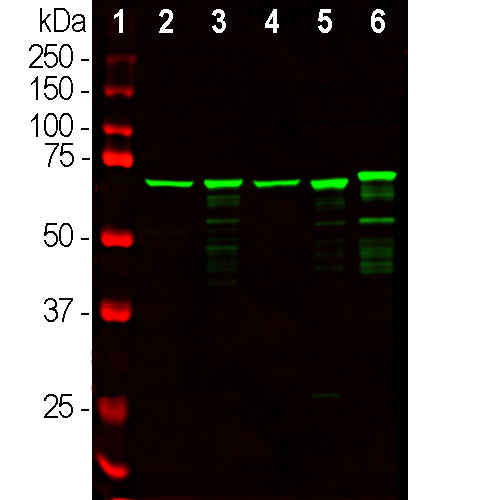

EnCor Biotechnology
Chicken Polyclonal Antibody to Neurofilament NF-L (Nfl, NEFL), Cat# CPCA-NF-L
Description
The CPCA-NF-L antibody was made against a preparation of full length human recombinant NF-L protein. It binds NF-L from a variety of species including human, rat and mouse. We document that the antibody works well not only for western blotting, IF and ICC but also on formalin fixed paraffin embedded sections, select the "Additional Data" for this data. We also generated highly specific rabbit polyclonal antibodies, RPCA-NF-L and RPCA-NF-L-ct, and several mouse monoclonal antibodies which have been epitope mapped and bind different forms of NF-L, MCA-DA2, MCA-6H63, and MCA-1D44.
- Cell Structure Marker
- Cell Type Marker
- Chicken Polyclonal Antibodies
- Cytoskeletal Marker
- Developmental Marker
- Immunohistochemistry Verified
Add a short description for this tabbed section
| Immunogen: | Recombinant human NF-L protein |
| HGNC Name: | NEFL |
| UniProt: | P07196 |
| Molecular Weight: | 68-70kDa by SDS-PAGE |
| Host: | Chicken |
| Species Cross-Reactivity: | Human, rat, mouse, cow, pig |
| RRID: | AB_2149931 |
| Format: | Concentrated IgY preparation plus 0.02% NaN3 |
| Applications: | WB, IF/ICC, IHC |
| Recommended Dilutions: | WB: 1:20,000. IF/ICC: 1:2,000. IHC: 1:4,000. |
| Storage: | Store at 4°C. Stable for 12 months from date of receipt. |
Neurofilaments are the 10nm or intermediate filament proteins found specifically in neurons, and are composed predominantly of three major proteins called NF-L, NF-M and NF-H, though other filament proteins may be included also. The major function of neurofilaments is likely to control the diameter of large axons (1). NF-L is the neurofilament light or low molecular weight polypeptide and runs on SDS-PAGE gels at 68-70kDa with some variability across species. Antibodies to NF-L like CPCA-NF-L are useful for identifying neuronal cells and their processes in cell culture and sectioned material. NF-L antibody can also be useful for the visualization of neurofilament rich accumulations seen in many neurological diseases, such as Lou Gehrig’s disease (ALS), giant axon neuropathy, Charcot-Marie Tooth disease and others (2-4). Much interest has recently been focused on the detection of NF-L released from neurons into blood and CSF as a surrogate marker of primarily axonal loss in a variety of types of CNS injury and degeneration (5).

Chromogenic immunostaining of a formalin fixed paraffin embedded human cerebellum with chicken pAb to NF-L, CPCA-NF-L, dilution 1:4,000, detected with DAB (brown) using the ABC method with citrate buffer retrieval at pH=6.0. Hematoxylin (blue) was used as the counterstain. The NF-L antibody detects perikaryal and dendritic processes of Purkinje cells and axons of other neuronal cells, particularly basket cells. Mouse select image for larger view.
1. Hoffman et al. Neurofilament gene expression:a major determinant of axonal caliber. PNAS 84:3472-6 (1987).
2. Perrot R, et al. Review of the Multiple Aspects of Neurofilament Functions, and their Possible Contribution to Neurodegeneration. Mol. Neurobiol. 38:27-65 (2008).
3. Lépinoux-Chambaud C. Eyer J. Review on intermediate filaments of the nervous system and their pathological alterations. Histochem. Cell Biol. 140:13-22 (2013).
4. Liu Q. et al. Neurofilamentopathy in Neurodegenerative Diseases. Open Neurol. J. 5:58–62 (2011).
5. Bacioglu M, et al. Neurofilament light chain in blood and CSF as marker of disease progression in mouse models and in neurodegenerative diseases. Neuron 91:56-66 (2016).
Add a short description for this tabbed section





